Stratum Ventilation: Enabling Simultaneous Energy Conservation and Air Purification in Subway Cars
Abstract
:1. Introduction
2. Materials and Methods
2.1. Technical Solution
2.2. Study Method
2.3. Model Validation
3. Results
3.1. Dilution Purification Performance
3.2. Energy Conservation Performance
3.2.1. Summer Air-Conditioning (AC) Fresh-Air Cooling Load (CLf)
3.2.2. Human Heat Dissipation Cooling Load (CLp)
3.2.3. Total Cooling Load (CLtot)
4. Discussion
5. Conclusions
- (1)
- A subway car with SV could supply fresh air to seated passengers through targeted ventilation. When the ventilation rate was 7200 m3/h, the CRE was 5.85% for the seated passengers, which was higher than that observed in the CV (1.89%) at the ventilation rate of 8500 m3/h. However, the effectiveness of contaminant removal from the upper part of the car was reduced from 0.94% to 0.65%.
- (2)
- Adding a middle row of air inlets in a subway car equipped with SV caused the air supply in the car to be more uniform. The temperature field of the entire car was significantly reduced in the cooling season, and the distribution area of hot air was also reduced.
- (3)
- The hourly cooling load, according to the CFD results, indicated that the cooling energy consumption was 14.05% lower in the Type-B single subway car equipped with SV than in that equipped with CV.
Author Contributions
Funding
Institutional Review Board Statement
Informed Consent Statement
Data Availability Statement
Conflicts of Interest
References
- The International Association for Public Transport. World Metro Figures 2021. Available online: https://cms.uitp.org/wp/wp-content/uploads/2022/05/Statistics-Brief-Metro-Figures-2021-web.pdf (accessed on 1 May 2022).
- Jiao, L.; Luo, F.; Wu, F.; Zhang, Y.; Huo, X.; Wu, Y. Can the opening of urban rail transit improve urban air quality? Evidence from 94 lines in China. Environ. Impact Assess. Rev. 2022, 97, 106857. [Google Scholar] [CrossRef]
- Guan, B.; Liu, X.; Zhang, T.; Wang, X. Hourly energy consumption characteristics of metro rail transit: Train traction versus station operation. EBE 2022, in press. [CrossRef]
- Meibom, P. Technology Analysis of Public Transport Modes. Technical University of Denmark. 2002. Available online: https://core.ac.uk/download/pdf/13738099.pdf (accessed on 1 January 2002).
- Zhao, Y.; Bi, H.; Wang, H. Air conditioning predictive control for rail transit vehicles based on load prediction. E3S Web Conf. 2020, 165, 04071. [Google Scholar] [CrossRef]
- Roy, D.; Lyou, E.S.; Kim, J.; Lee, T.K.; Park, J. Commuters health risk associated with particulate matter exposures in subway system—Globally. Build. Environ 2022, 216, 109036. [Google Scholar] [CrossRef]
- Peng, L.; Shen, Y.; Gao, W.; Zhou, J.; Pan, L.; Kan, H.; Cai, J. Personal exposure to PM2.5 in five commuting modes under hazy and non-hazy conditions. Environ. Pollut. 2021, 289, 117823. [Google Scholar] [CrossRef] [PubMed]
- Huang, S.; Chen, P.; Hu, K.; Qiu, Y.; Feng, W.; Ren, Z.; Wang, X.; Huang, T.; Wu, D. Characteristics and source identification of fine particles in the Nanchang subway, China. Build. Environ. 2021, 199, 107925. [Google Scholar] [CrossRef]
- Tan, L.; Ma, C. Choice behavior of commuters’ rail transit mode during the COVID-19 pandemic based on logistic model. J. Traffic. Transport. Eng. 2021, 8, 186–195. [Google Scholar] [CrossRef]
- Harris, J.E. The Subways Seeded the Massive Coronavirus Epidemic in New York City. Available online: https://ssrn.com/abstract=3580579 (accessed on 30 April 2020).
- Quan, Z.; Xiao, X. Promoting Balanced Supply and Demand in Subway Operation; Beijing Observation: Beijing, China, 2022; pp. 44–45. (In Chinese) [Google Scholar]
- Alkalamouni, H.; Hitti, E.; Zaraket, H. Adopting fresh air ventilation may reduce the risk of airborne transmission of SARS-CoV-2 in COVID-19 unit. J. Infect. 2021, 83, e4–e5. [Google Scholar] [CrossRef]
- Nair, A.N.; Anand, P.; George, A.; Monda, N. A review of strategies and their effectiveness in reducing indoor airborne transmission and improving indoor air quality. Environ. Res. 2022, 213, 113579. [Google Scholar] [CrossRef]
- Vlaskin, M.S. Review of air disinfection approaches and proposal for thermal inactivation of airborne viruses as a life-style and an instrument to fight pandemics. Appl. Therm. Eng. 2022, 202, 117855. [Google Scholar] [CrossRef]
- Liu, H.; Zhang, S.; Liu, L.; Yu, J.; Ding, B. High-performance filters from biomimetic wet-adhesive nanoarchitectured networks. J. Mater. Chem. A 2020, 8, 18955–18962. [Google Scholar] [CrossRef]
- Zuo, F.; Zhang, S.; Liu, H.; Fong, H.; Yin, X.; Yu, J.; Ding, B. Free-standing polyurethane nanofiber/nets air filters for effective pm capture. Small 2017, 13, 1702139. [Google Scholar] [CrossRef] [PubMed]
- Feng, Z.; Cao, S. A newly developed electrostatic enhanced pleated air filters towards the improvement of energy and filtration efficiency. Sustain. Cities Soc. 2019, 49, 101569. [Google Scholar] [CrossRef]
- Yuasa, H. Railway-Car Total Heat Exchange Ventilation System. U.S. Patent 20150344044, 3 December 2015. [Google Scholar]
- Lee, K.W. Air Ventilating and Sterilizing Apparatus Made of Copper. U.S. Patent 20170128607, 26 December 2017. [Google Scholar]
- Sims, D.M., Jr. Ventilation System and Method for Killing Airborne Infectious Bacteria, Viruses and Other Pathogens. U.S. Patent 20220034526, 3 February 2022. [Google Scholar]
- Ren, C.; Cao, S.; Feng, Z. A Replacement Ventilation Device for Subway Cars. China Patent CN208312625U, 11 May 2018. Available online: http://epub.cnipa.gov.cn/patent/CN208312625U (accessed on 1 January 2019). (In Chinese).
- Ren, J.; Tang, M.; Novoselac, A. Experimental study to quantify airborne particle deposition onto and resuspension from clothing using a fluorescent-tracking method. Build. Environ. 2022, 209, 108580. [Google Scholar] [CrossRef] [PubMed]
- Lin, Z. Stratum ventilation—A low-carbon way to thermal comfort and indoor air quality. Int. J. Low-Carbon Technol. 2017, 12, 323–329. [Google Scholar] [CrossRef] [Green Version]
- Li, H.; Fu, Z.; Xi, C.; Li, N.; Li, W.; Kong, X. Study on the impact of parallel jet spacing on the performance of multi-jet stratum ventilation. Appl. Energy 2022, 306, 118135. [Google Scholar] [CrossRef] [PubMed]
- Zhang, S.; Lin, Z. Dilution-based evaluation of airborne infection risk-thorough expansion of Wells- Riley model. Build. Environ. 2021, 194, 107674. [Google Scholar] [CrossRef]
- Tian, L.; Lin, Z.; Wang, Q.; Liu, J. Numerical investigation of indoor aerosol particle dispersion under stratum ventilation and under displacement ventilation. Indoor Built. Environ. 2009, 18, 360–375. [Google Scholar] [CrossRef]
- Zhang, L.; Mao, Y.; Tu, Q.; Wu, X.; Tan, L. Effects of supply parameters of stratum ventilation on energy utilization efficiency and indoor thermal comfort: A computational approach. Math. Probl. Eng. 2021, 2021, 6615148. [Google Scholar] [CrossRef]
- Kong, X.; Xi, C.; Li, H.; Lin, Z. Multi-parameter performance optimization for whole year operation of stratum ventilation in offices. Appl. Energy 2020, 268, 114966. [Google Scholar]
- Bai, Y.; Wang, T.; Wan, T. Multi-criteria performance dynamic optimization for heating operation of stratum ventilation considering different metabolic rates. Arab J. Sci. Eng. 2022. [Google Scholar] [CrossRef]
- Mao, Y.; Hou, F.; Zhang, X.; Shen, H.; Gao, Y.; Wang, J. Stratum Ventilation System Air Conditioning Terminal for Subway cars. China Patent CN214450955U, 14 May 2021. Available online: http://epub.cnipa.gov.cn/patent/CN214450955U (accessed on 22 October 2021). (In Chinese).
- Mao, Y.; Ma, J.; Wang, S.; Liang, J.D.; Liang, J.Z. A stratum ventilation system for pollutants and an improved prediction model for infection in subway cars. Atmos Pollut. Res. 2022, 13, 101354. [Google Scholar] [CrossRef]
- Jiang, Y.; Zhao, B.; Li, X.; Zhang, Z.; Zhang, Y. Investigating a safe ventilation rate for the prevention of indoor SARS transmission: An attempt based on a simulation approach. Build. Simul. 2009, 2, 281–289. [Google Scholar] [CrossRef] [PubMed]
- Shen, C.; Gao, N.; Wang, T. CFD study on the transmission of indoor pollutants under personalized ventilation. Build. Environ. 2013, 63, 69–78. [Google Scholar] [CrossRef]
- Chew, L.W.; Chen, C.; Gorlé, C. Improving thermal model predictions for naturally ventilated buildings using large eddy simulations. Build. Environ. 2022, 220, 109241. [Google Scholar] [CrossRef]
- Gilani, S.; Montazeri, H.; Blocken, B. CFD simulation of stratified indoor environment in displacement ventilation: Validation and sensitivity analysis. Build. Environ. 2016, 95, 299–313. [Google Scholar] [CrossRef]
- Chen, C.; Zhao, B.; Lai, D.; Liu, W. A simple method for differentiating direct and indirect exposure to exhaled contaminants in mechanically ventilated rooms. Build. Simul. 2018, 11, 1039–1051. [Google Scholar] [CrossRef]
- Yu, F.; Thierry, M.; Ted, S.; Hang, Y. Influence of wind and relative humidity on the social distancing effectiveness to prevent COVID-19 airborne transmission: A numerical study. J. Aerosol. Sci. 2020, 147, 105585. [Google Scholar]
- Zhdanov, V.P.; Kasemo, B. Virions and respiratory droplets in air: Diffusion, drift, and contact with the epithelium. Biosystems 2020, 198, 104241. [Google Scholar] [CrossRef]
- Zhou, Y.; Shen, J. Experimental and numerical study on the transport of droplet aerosols generated by occupants in a fever clinic. Build. Environ. 2021, 187, 107402. [Google Scholar] [CrossRef]
- Gilio, A.D.; Palmisani, J.; Pulimeno, M.; Cerino, F.; Cacace, M.; Miani, A.; Gennaro, G. CO2 concentration monitoring inside educational buildings as a strategic tool to reduce the risk of Sars-CoV-2 airborne transmission. Environ. Res. 2021, 202, 111560. [Google Scholar] [CrossRef] [PubMed]
- Bhagat, R.K.; Wykes, M.S.D.; Dalziel, S.B.; Linden, P.F. Effects of ventilation on the indoor spread of COVID-19. J. Fluid Mech. 2020, 903. [Google Scholar] [CrossRef] [PubMed]
- Zhu, Y. Architectural Environment; China Architecture & Building Press: Beijing, China, 2016. (In Chinese) [Google Scholar]
- Yang, Y. Design of Type-B Subway AC Ventilation System and Simulation and Verification of Passenger Area Flow Field; Dalian Jiaotong University: Dalian, China, 2020. (In Chinese) [Google Scholar]
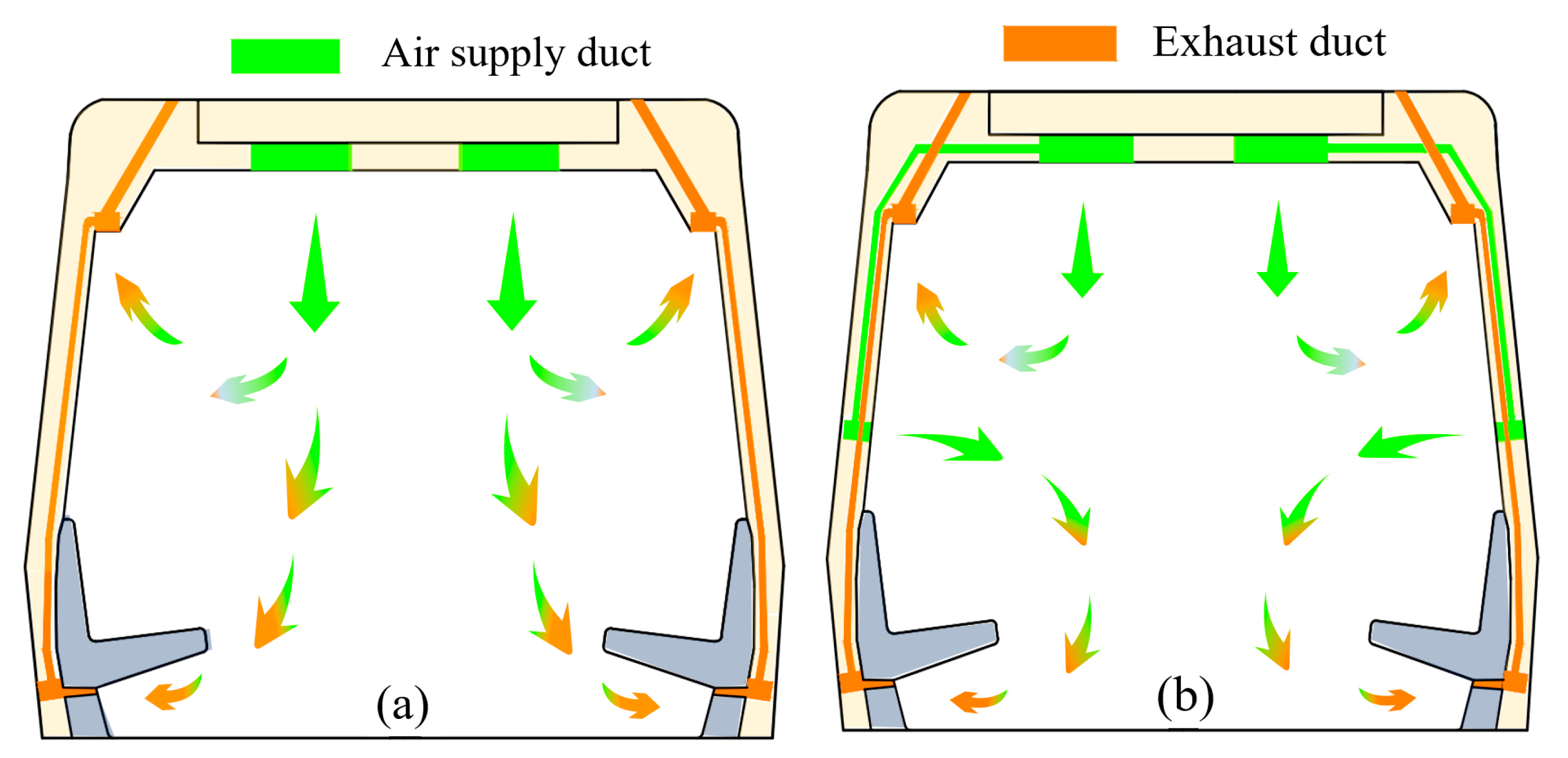
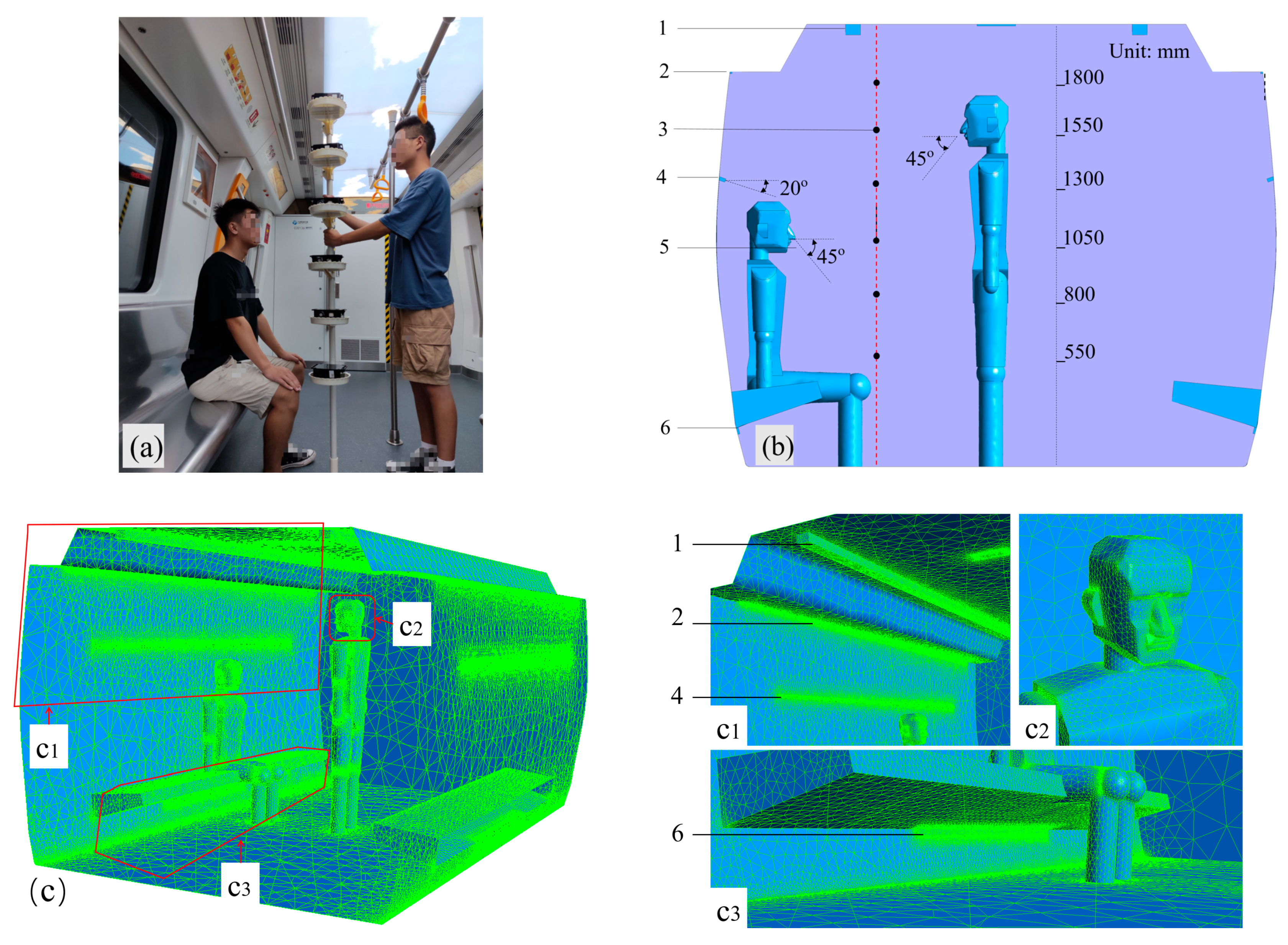


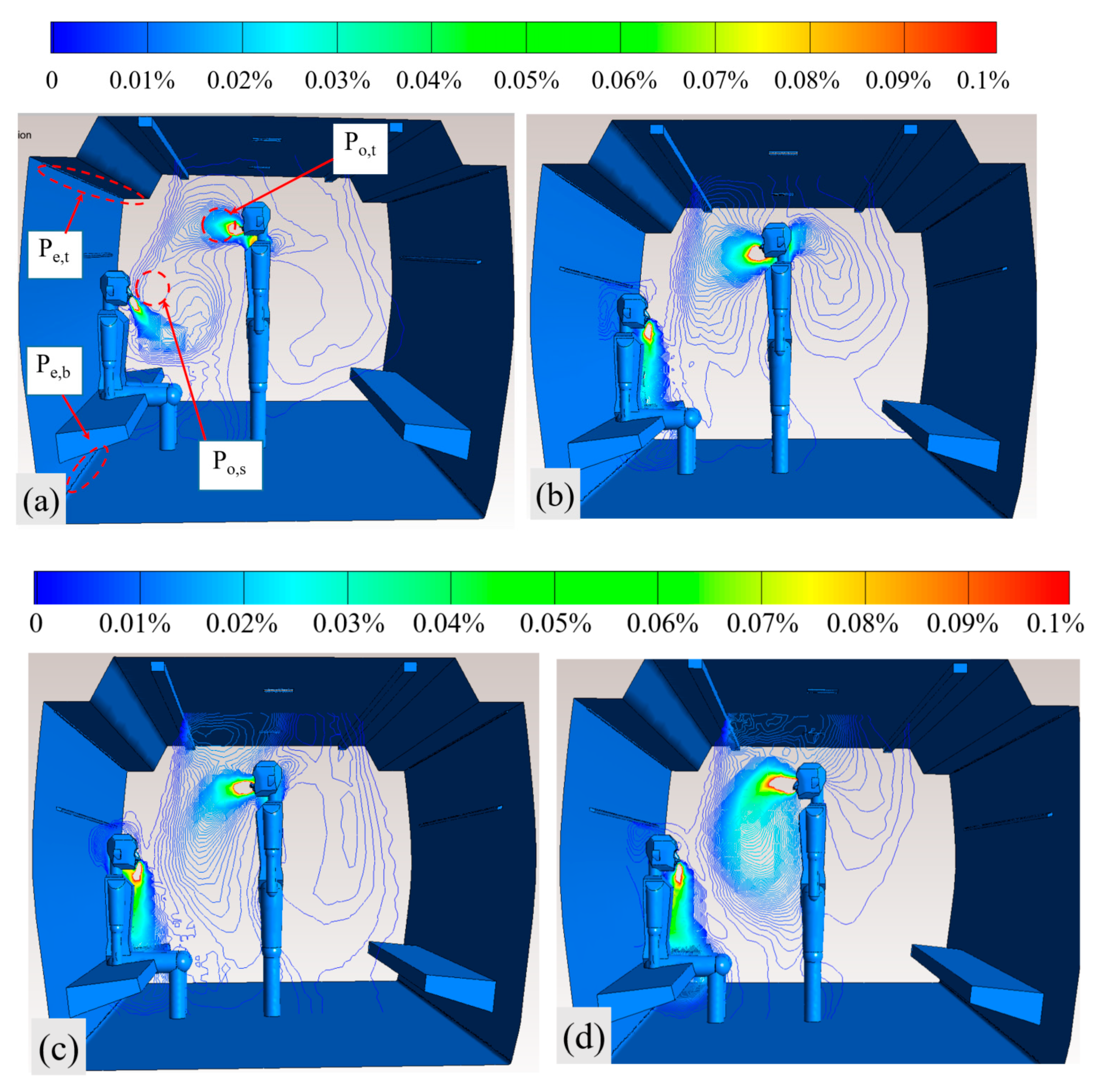
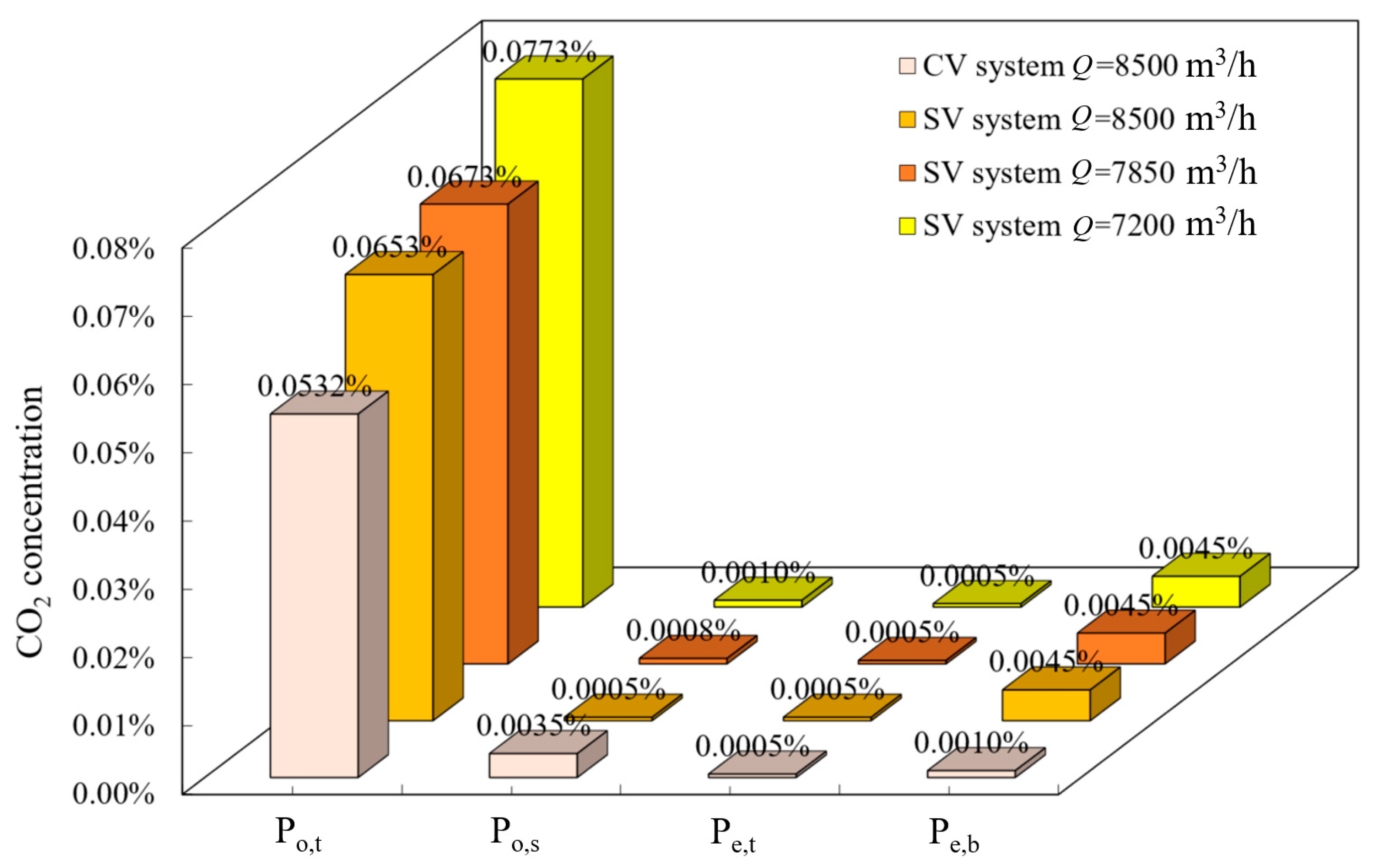
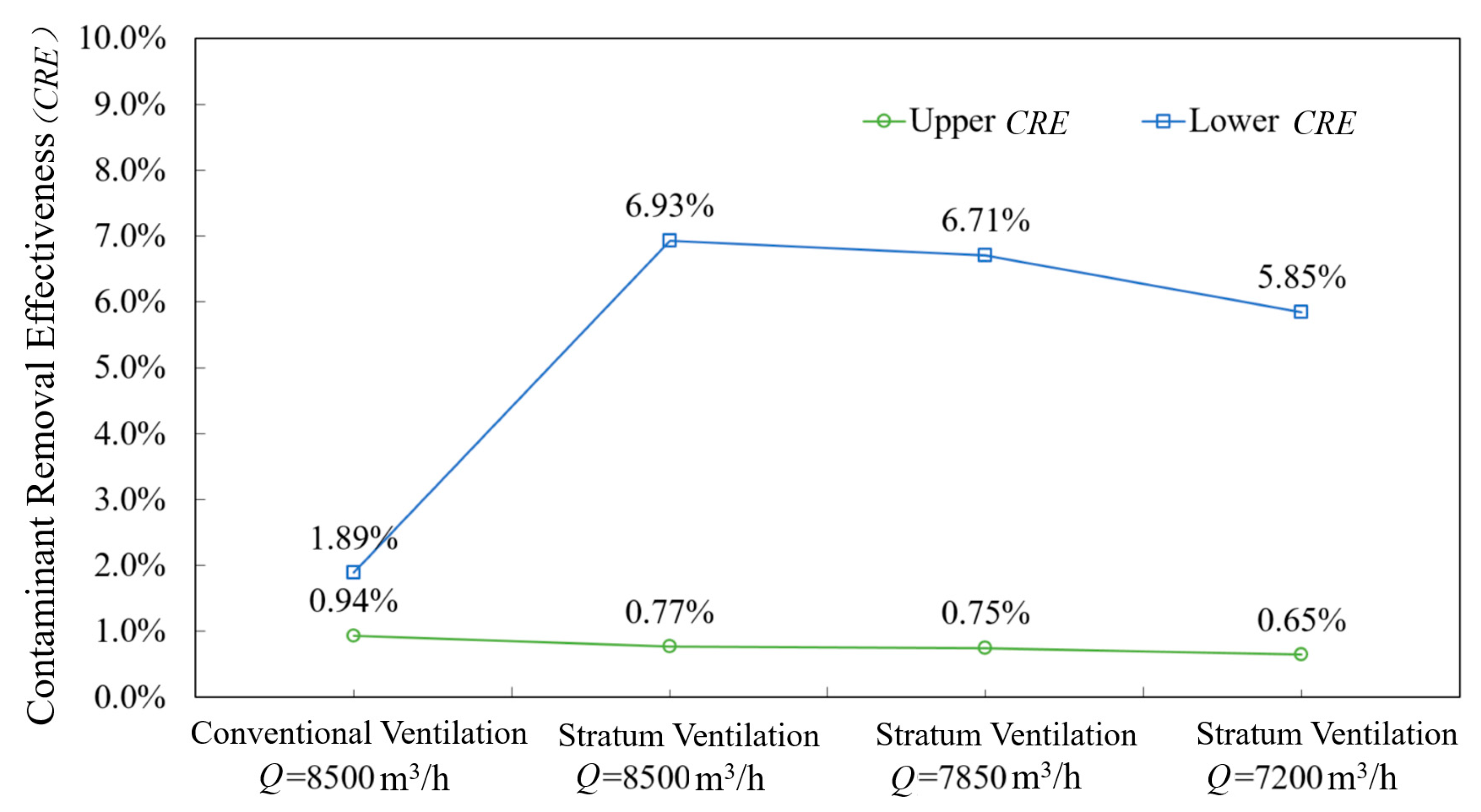
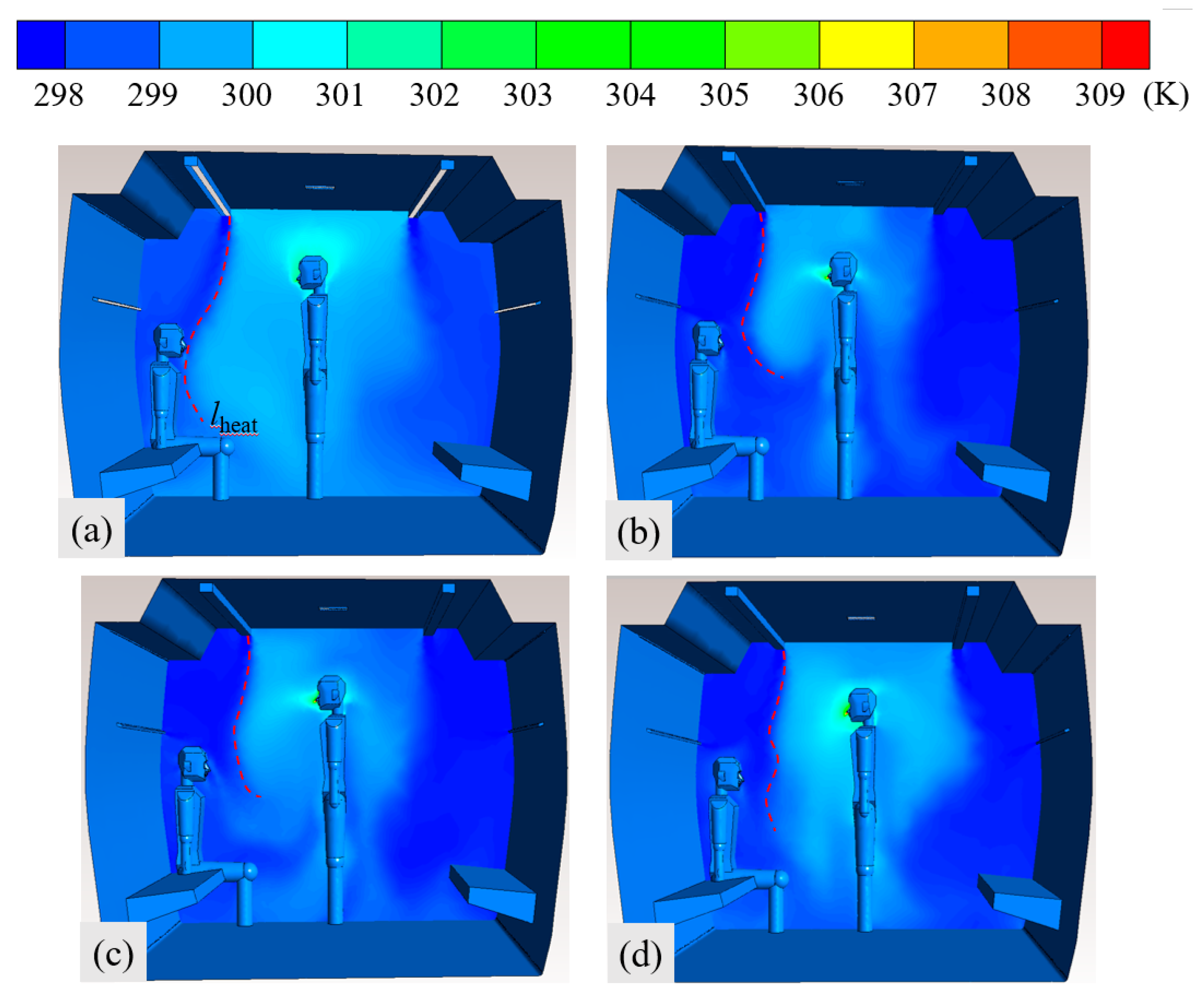
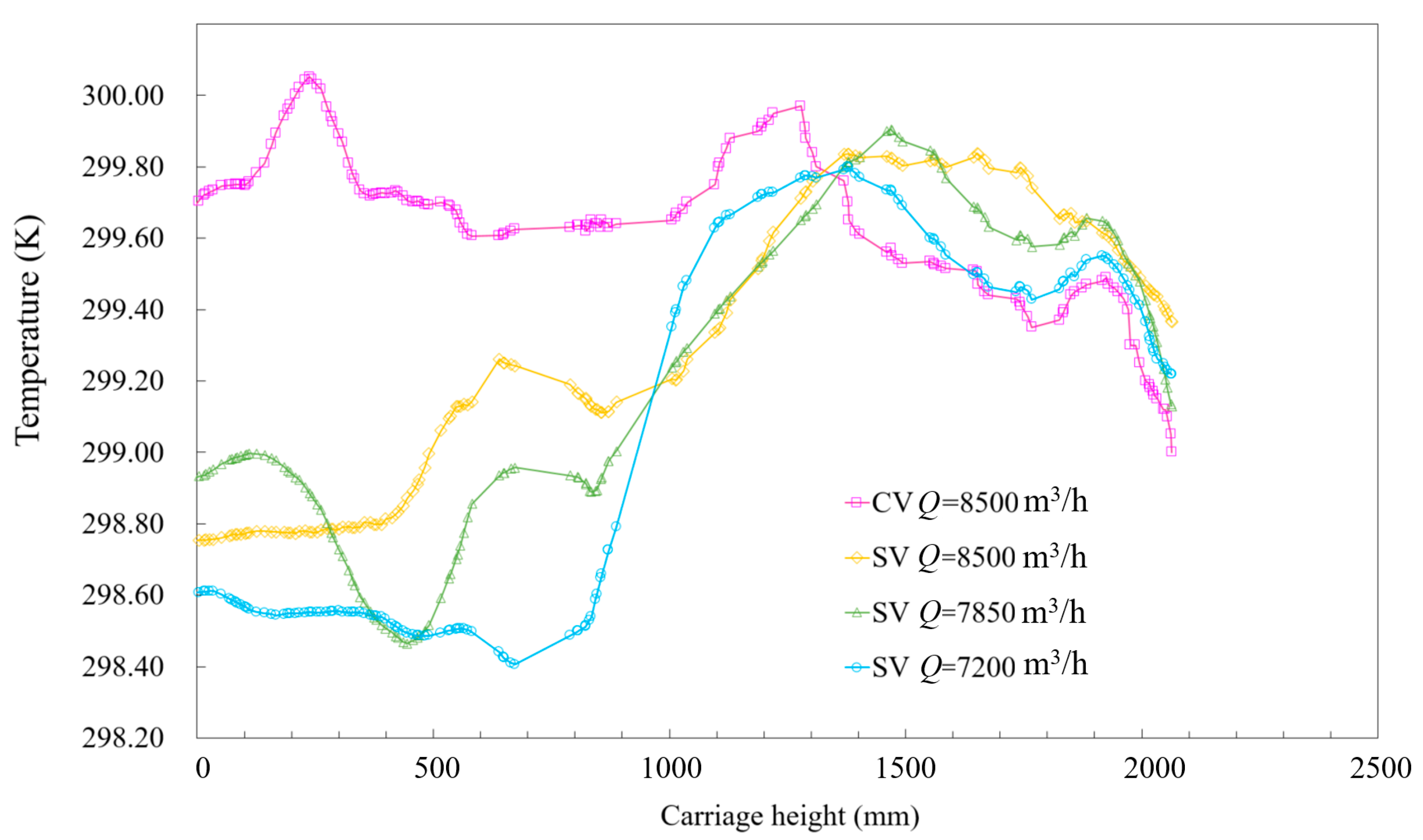
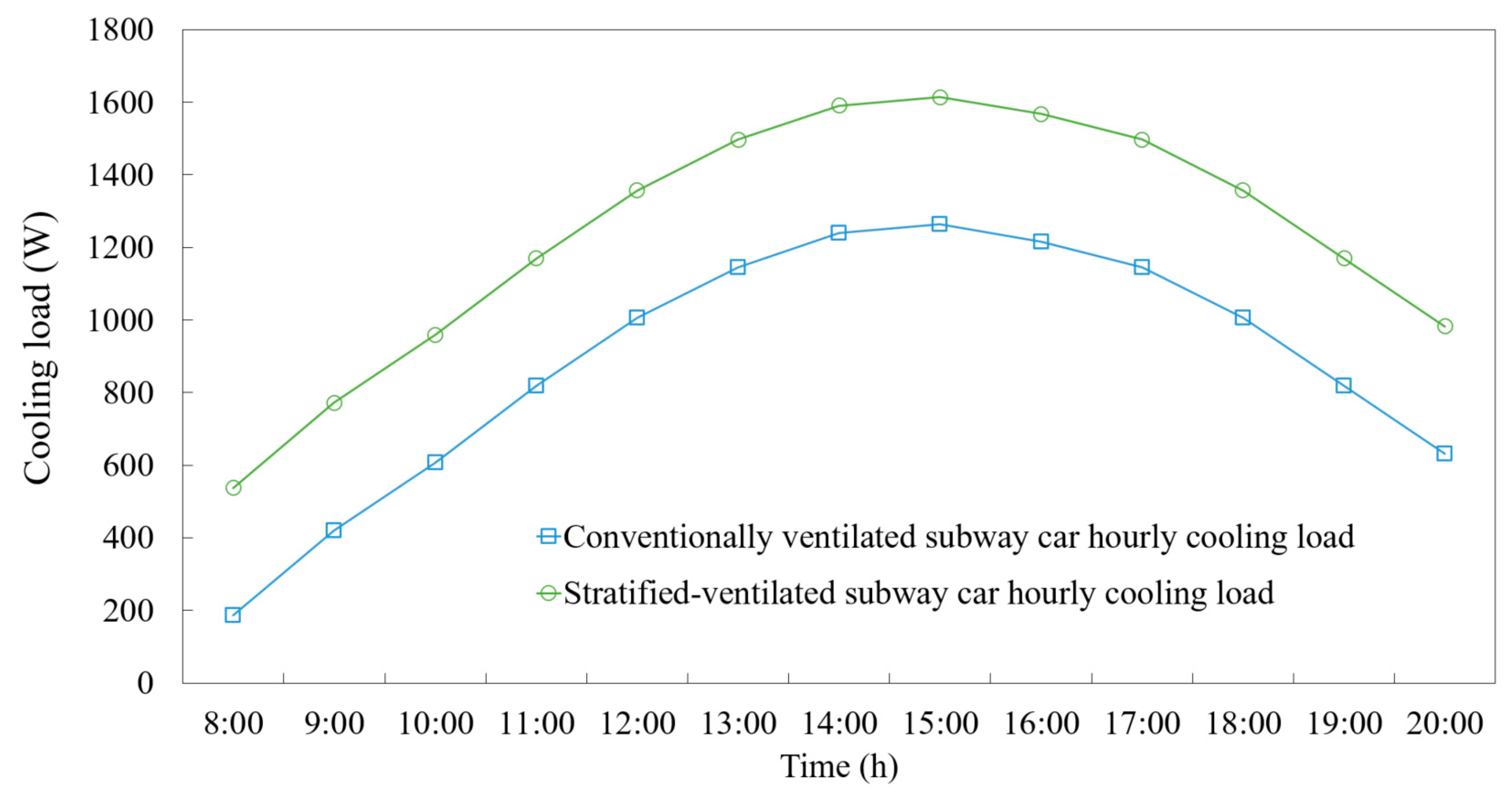
| Boundary Conditions | Type | Parameters | Initial Conditions | Parameters |
|---|---|---|---|---|
| Ceiling air supply inlet | Mass flow inlet | 0.76 kg/s, 298 K | Internal CO2 | 0% |
| Air exhaust outlet at the intersection of the car body and ceiling | Pressure outlet | 0 Pa, 298 K | Internal N2 | 78% |
| Air supply inlet in the middle of subway body | Mass flow inlet | 0.76 kg/s, 298 K | Internal O2 | 22% |
| Air exhaust outlet below seats | Pressure outlet | 0 Pa, 298 K | Passenger exhaled CO2 | 4% |
| Exhaled gas flow of passengers | Mass flow inlet | 1.07 × 10−4 kg/s, 309 K | Internal initial temperature | 309 K |
| Parameter | CV | SV |
|---|---|---|
| Temperature of air supply (K) | 298 | 298 |
| Average in-car temperature (K) | 301.5 | 300 |
| Design temperature (K) | 299 | 299 |
| Relative humidity (%) | 50 | 50 |
| Air enthalpy (kJ·kg−1) | 52.91 | 52.91 |
| Ventilation flow rate (m3·h−1) | 8500 | 7200 |
| Fresh air requirement (m3·h−1) | 2600 | 2200 |
| Temperature (K) | Relative Humidity (%) | Air Density (kg·m−3) | Enthalpy (kJ·kg−1) |
|---|---|---|---|
| 308 | 68 | 1.293 | 97.85 |
| Time (h) | 8:00 | 9:00 | 10:00 | 11:00 | 12:00 | 13:00 | 14:00 | 15:00 | 16:00 | 17:00 | 18:00 | 19:00 | 20:00 |
|---|---|---|---|---|---|---|---|---|---|---|---|---|---|
| Tw/K | 302.3 | 303.3 | 304.1 | 305 | 305.8 | 306.4 | 306.8 | 306.9 | 306.7 | 306.4 | 305.8 | 305 | 304.2 |
| Tn,1/K | 301.5 | 301.5 | 301.5 | 301.5 | 301.5 | 301.5 | 301.5 | 301.5 | 301.5 | 301.5 | 301.5 | 301.5 | 301.5 |
| Tn,2/K | 300 | 300 | 300 | 300 | 300 | 300 | 300 | 300 | 300 | 300 | 300 | 300 | 300 |
Publisher’s Note: MDPI stays neutral with regard to jurisdictional claims in published maps and institutional affiliations. |
© 2022 by the authors. Licensee MDPI, Basel, Switzerland. This article is an open access article distributed under the terms and conditions of the Creative Commons Attribution (CC BY) license (https://creativecommons.org/licenses/by/4.0/).
Share and Cite
Mao, Y.; Wang, S.; Liang, J.; Mao, S.; Han, Y.; Zhang, S. Stratum Ventilation: Enabling Simultaneous Energy Conservation and Air Purification in Subway Cars. Int. J. Environ. Res. Public Health 2022, 19, 14521. https://doi.org/10.3390/ijerph192114521
Mao Y, Wang S, Liang J, Mao S, Han Y, Zhang S. Stratum Ventilation: Enabling Simultaneous Energy Conservation and Air Purification in Subway Cars. International Journal of Environmental Research and Public Health. 2022; 19(21):14521. https://doi.org/10.3390/ijerph192114521
Chicago/Turabian StyleMao, Yanhui, Shengxu Wang, Jianzhou Liang, Saiqin Mao, Yukun Han, and Shengquan Zhang. 2022. "Stratum Ventilation: Enabling Simultaneous Energy Conservation and Air Purification in Subway Cars" International Journal of Environmental Research and Public Health 19, no. 21: 14521. https://doi.org/10.3390/ijerph192114521





